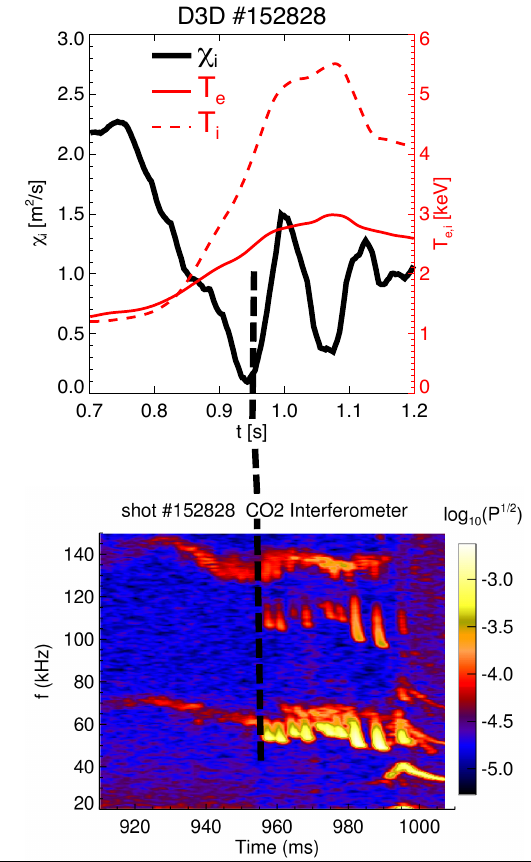References:
[1] V. N. Duarte, H. L. Berk, N. N. Gorelenkov,
t al., "Prediction of nonlinear evolution
character of energetic-particle-driven instabilities," Nucl.
Fusion, vol. 57, no. 5, p.
054 001, 2017
[2] P. Lauber et al., "Strongly non-linear energetic particle dynamics in asdex upgrade scenarios with core impurity accumulation," in 27th IAEA Fusion Energy Conference (FEC), 2018;
[3] M. V. Zeeland et al.,"Alfv ́en eigenmodes and fast ion transport in negative triangularity DIII-d plasmas," Nucl. Fusion, vol. 59, no. 8, p. 086 028, Jun. 2019. doi: 10.1088/1741-4326/ab2488;
[4] V. N. Duarte, N. N. Gorelenkov et al., "Study of the likelihood of alfvenic mode bifurcation in nstx and
predictions for iter baseline scenarios," Nucl. Fusion, vol. 58, no. 8, p. 082 013, 2018.
[5] H. L. Berk, B. N. Breizman, and M. Pekker, "Nonlinear dynamics of a driven
mode near marginal stability," Phys. Rev. Lett., vol. 76, p. 1256, 8 Feb.
1996. doi: 10.1103/PhysRevLett.76.1256.
[6] M. K. Lilley, B. N. Breizman, and S. E. Sharapov, "Destabilizing effect of dynamical friction on fast-particle-driven waves in a near-threshold nonlinear regime," Phys. Rev. Lett., vol. 102, no. 19, 2009. doi: http://dx.doi.org/10.1103/PhysRevLett.102.195003]
[7] V. N. Duarte, H. L. Berk, N. N. Gorelenkov, W. W. Heidbrink, G. J. Kramer, R. Nazikian, D. C. Pace, M. Podest`a, B. J. Tobias, and M. A. Van Zeeland, "Prediction of nonlinear evolution character of energetic-particle-driven instabilities," Nucl. Fusion, vol. 57, no. 5, p. 054 001, 2017;
[8] V. N. Duarte, H. L. Berk, N. N. Gorelenkov, W. W. Heidbrink, G. J. Kramer, R.
Nazikian, D. C. Pace, M. Podesta, and M. A. V. Zeeland, "Theory and observation
of the onset of nonlinear structures due to eigenmode destabilization by fast ions
in tokamaks," Phys. of Plasmas, vol. 24, p. 122 508, 2017
[9] S. Kaye et al., "Confinement and local transport in the national spherical torus
experiment (NSTX)," Nucl. Fusion, vol. 47, no. 7, p. 499, Jun. 2007. doi:
10.1088/0029-5515/47/7/001.
[10] J. Lang and G.-Y. Fu, "Nonlinear simulation of toroidal Alfv ́en eigenmode with microturbulence-induced radial diffusion," Phys. Plasmas, vol. 18, no. 5, p. 055 902, 2011. doi: 10.1063/1.N. 3574503.
[11] N. N. Gorelenkov, C. Z. Cheng, G. Y. Fu, Phys. Plasmas 6 (1999) 2802.

[2] P. Lauber et al., "Strongly non-linear energetic particle dynamics in asdex upgrade scenarios with core impurity accumulation," in 27th IAEA Fusion Energy Conference (FEC), 2018;
[3] M. V. Zeeland et al.,"Alfv ́en eigenmodes and fast ion transport in negative triangularity DIII-d plasmas," Nucl. Fusion, vol. 59, no. 8, p. 086 028, Jun. 2019. doi: 10.1088/1741-4326/ab2488;
[4] V. N. Duarte, N. N. Gorelenkov et al., "Study of the likelihood of alfvenic mode bifurcation in nstx and
predictions for iter baseline scenarios," Nucl. Fusion, vol. 58, no. 8, p. 082 013, 2018.
[5] H. L. Berk, B. N. Breizman, and M. Pekker, "Nonlinear dynamics of a driven
mode near marginal stability," Phys. Rev. Lett., vol. 76, p. 1256, 8 Feb.
1996. doi: 10.1103/PhysRevLett.76.1256.
[6] M. K. Lilley, B. N. Breizman, and S. E. Sharapov, "Destabilizing effect of dynamical friction on fast-particle-driven waves in a near-threshold nonlinear regime," Phys. Rev. Lett., vol. 102, no. 19, 2009. doi: http://dx.doi.org/10.1103/PhysRevLett.102.195003]
[7] V. N. Duarte, H. L. Berk, N. N. Gorelenkov, W. W. Heidbrink, G. J. Kramer, R. Nazikian, D. C. Pace, M. Podest`a, B. J. Tobias, and M. A. Van Zeeland, "Prediction of nonlinear evolution character of energetic-particle-driven instabilities," Nucl. Fusion, vol. 57, no. 5, p. 054 001, 2017;
[8] V. N. Duarte, H. L. Berk, N. N. Gorelenkov, W. W. Heidbrink, G. J. Kramer, R.
Nazikian, D. C. Pace, M. Podesta, and M. A. V. Zeeland, "Theory and observation
of the onset of nonlinear structures due to eigenmode destabilization by fast ions
in tokamaks," Phys. of Plasmas, vol. 24, p. 122 508, 2017
[9] S. Kaye et al., "Confinement and local transport in the national spherical torus
experiment (NSTX)," Nucl. Fusion, vol. 47, no. 7, p. 499, Jun. 2007. doi:
10.1088/0029-5515/47/7/001.
[10] J. Lang and G.-Y. Fu, "Nonlinear simulation of toroidal Alfv ́en eigenmode with microturbulence-induced radial diffusion," Phys. Plasmas, vol. 18, no. 5, p. 055 902, 2011. doi: 10.1063/1.N. 3574503.
[11] N. N. Gorelenkov, C. Z. Cheng, G. Y. Fu, Phys. Plasmas 6 (1999) 2802.
